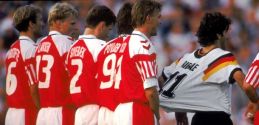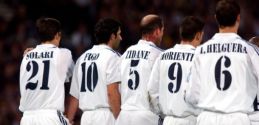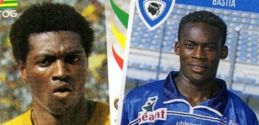 1 comments
1 comments
Latin Wonderkids: Part Three of David N’s peak into South America’s football future
In what has become something of an annual post, here I’ll take a look at some of the youngsters lighting up South American football at the moment and probably destined for a future in the Champions League. Last year’s selection included Erik Lamela (now of Roma), Diego Rubio (now at Sporting Lisbon) and Juan Manuel Iturbe (now Porto) and I have a feeling most of this crop will be at big European clubs by this time next year:
PAULO DYBALA of Instituto de Cordoba
It’s instructive that probably the two hottest young talents in Argentine football at the moment both play in the Primera B, the league’s second division. Young talent doesn’t last long in Argentina, with all of the European giants sniffing around academies and scouting games at youth levels throughout the country in the hope of finding another Messi or Aguero on the cheap. I’ll get to the second player later, but at 18 years of age, Dybala (top) is probably the hottest youngster in Argentina right now.
It helps that he plays for the hipster’s choice. Instituto are the third or fourth club in Cordoba, behind Talleres and Belgrano, but their current side plays mesmerically lovely, blisteringly direct attacking football, and they are currently on top of the Primera B ahead of slumming giants River Plate and Rosario Central.
Dybala has played a big part in that with 17 goals in 28 games this season. But he contributes more than goals. The quintessential modern forward, he pulls left and right, instigates moves, runs the channels, likes to play cute little through-balls and one-touch flicks in the build-up, and can dribble at pace as well as possessing the ice cool calm of the natural finisher. He already seems to be close to the finished article, and Inter Milan have been persistently linked with him, however much he - and the Argentine game in general - would like him to have at least one season in the Primera Division.
However, on 28 April Palermo president Maurizio Zamparini told Sky Sport Italia: “We have secured Paulo Dybala. He is the new Sergio Aguero.” This has yet to be formally confirmed though, with recent reports suggesting it’s only a pre-contract agreement.
CASEMIRO of São Paolo
At 20, Casemiro has already played 40 games for São Paolo and made his debut for Brazil’s senior side, and he looks like he could be one of his countries key players over the next decade.
An aggressive, physically impressive central midfielder, he is a capable athlete, motoring his burly six foot frame across the pitch relentlessly to close down opposition attacks and reclaim possession with sharp tackling and positional intelligence. That would be enough for many players - truly efficient holding midfielders are hard to find these days - but Casemiro has the technique to back it up. Capable of playing accurate raking passes to his forwards - Hernanes is one of his idols, and he learned at his feet - and also smart enough to know when to play it short, quick and simple, many of São Paolo’s attacks begin on his boot.
In addition, he’s a real threat from set-pieces, with the aerial ability and physical presence to worry defences. Milan are continually linked with him, and I doubt he’ll follow Hernanes in making a relatively late move to Europe.
SEBASTIÁN UBILLA of Santiago Wanderers
Ubilla has exploded in the Chilean Apertura tournament with 11 goals from 10 games, in a few months doubling his tally for a club he’s played for since 2008. At 21, it seems he’s ready to fulfil a talent that makes it easy to compare him to the new breed of attacker seen in Chilean football over the last few years; explosive, versatile players like Eduardo Vargas and Alexis Sanchez.
At Santiago Wanderers he plays more as an out-and-out striker than either of those players, but like them he tends to wander (no pun intended) towards the wing, stretching defences and allowing him to attack with his pace and dribbling ability. Like Dybala, he is just as valuable for his link-play as his finishing, and it is his genuine ability with either foot which seems to make him so unpredictable; he can go past players on either side, a talent that terrifies defenders.
Chileans have recently done well in Serie A, and so, predictably, a host of Italian clubs are jostling for his signature, with Udinese and Cagliari reportedly favourites.
TABARÉ VIUDEZ of Nacional
Viudez has already been picked up by a European giant. In 2008, when he was 19, Milan signed him from Defensor Sporting, and he made several pre-season appearances and one substitute outing for the club before returning to Uruguay at the end of that season. Since then, Defensor have sold him to Mexican giants Club América, who in turn loaned him out to Necaxa - where he featured little - before loaning him to Nacional, one of Uruguay’s Big Two.
There he has been given the number 10 shirt and displayed the talent that first attracted Milan, playing as a second striker and scoring nine goals in 25 games. He had featured in the classy 2009 Under-20 Uruguayan side alongside the likes of Nicolas Lodiero, Abel Hernandez and Santiago Garcia.
In that side he played as a winger, with scorching pace and fine dribbling skills allied to a good dead ball ability, but the move into a front two demonstrates his versatility. Hopefully, the damage done by such a disappointing experience in Europe won’t effect his development too much, for at 22 he remains a great prospect.
HÉCTOR CANTEROS of Velez Sarsfield
When Argentina played Brazil in the revived Copa Roca in September 2011, with two sides featuring only players from the countries domestic leagues, a surprising name appeared on the sacred number 10 shirt for the Argentineans.
Hector Canteros was not yet fully, unequivocally established in the Velez Sarsfield first team, and he tended to play a deeper role in midfield for his club. Yet Argentina Coach Alejandro Sabella trusted him to run the game from the area between midfield and attack, and he was arguably the dominant figure on the pitch that night, exhibiting an impressive range and variety of passing, long and short, controlling the play, maintaining possession and orchestrating attacks, while also sticking his foot in and breaking up Brazilian moves at their source in midfield.
This was no great surprise to observers of Velez. Canteros has shone whenever he has played for his club, combining creativity, hard work and steel in a classy package. He looked assured and unfazed from his debut, and has continued in the same manner, aided perhaps by his involvement with one of the most consistently attractive and competitive sides in South America as at Velez he has been surrounded by quality ball-players of the calibre of Maxi Moralez, David Ramirez, Ricky Alvarez and Augusto Fernandez.
This seems to have encouraged him and his development has been steady and promising; he seems ready for Europe already.
DEDÉ of Vasco Da Gama
Fans of his club have nicknamed him “Dedéckenbauer”, which gives some indication of the sort of player we’re talking about. His recent debut for the senior Brazilian national team felt like the first of many, as if we were seeing the player who may well be playing alongside the mighty Thiago Silva in many future World Cups. Dedé inspires such sweeping judgements.
Tall, athletic, elegant, and impressive on the ball, he has been a key element in Vasco Da Gamas consistent competitiveness over the past couple of years. He likes to distribute from the back, chips in with the odd goal, and marauds forward when the situation demands it (and even sometimes when it doesn’t). He also displays enough character and personality to seem like the team’s natural leader, and that at the age of 23.
But he has his flaws. He gets drawn out of defence to the ball too often. He joins in attacks upon the opposition goal too, leaving his team short at the back and vulnerable to quick counters. But he is young and still learning. Central defenders tend to peak slightly later than other outfield players, and Dedé has plenty of time to learn. When he does, it looks like he could be a truly great footballer.
MAURO CABALLERO of Libertad
Caballero’s father is a legend in Paraguay; highest-ever scorer for Ascuncion’s Olimpia, multiple Paraguayan championship winner, owner of a Copa Libertadores winner’s medal and a Paraguayan international, his son “Maurito” has a lot to live up to.
But at just 17 years of age, it appears that he may be capable of doing just that. He first came to prominence at the 2009 Under-15 South American Championship, and showed that he had matured and progressed with his performances in last year’s Under-17 equivalent, during which he scored five goals. Since then he has started to appear for Libertad’s first team, scoring on his debut and twice turning Libertadores games his clubs way when he was brought off the bench.
He is a great penalty area striker; sharp and aware, with a lethal left foot and good aerial technique. He is also pacy and inventive and a constant threat to opposition defences.
Barcelona and Manchester City have already been linked…
More of David N’s musings on world football can be found on his Twitter page and his diversity knows no bounds, as he also writes excellent capsule film reviews.
Tags: , , , , , , , , Premier LeagueShare this article
Leave a comment
- When did co-commentary become such a serious and miserable business?
- Why do we devote so much time to sharing our love of football for free?
- Villa’s Tokyo downfall: The apparent formality of a world title match
- Son Heung-min and the forgotten wonder goals
- Guess the Premier League goalscorer from the GIF
- A fateful flight
- Goodbye to the instant analogue gratification of Ceefax
- Player Profile: Steve Ogrizovic
- Rejecting FA Cup money in favour of a car boot sale
- It’s a man’s world? Former Arsenal manager crosses the gender divide











